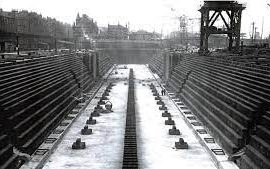
Govan was once a small fishing village on the edge of the Clyde, but became a worldwide centre for heavy engineering (and shipbuilding in particular) in the 19th and 20th centuries.Govan (/ˈɡʌvən/ GUV-ən; Scottish Gaelic: Baile a’ Ghobhainn) is a district and former burgh now part of southwest City of Glasgow, Scotland. It is situated 2.5 miles (4.0 km) west of Glasgow city centre, on the south bank of the River Clyde, opposite the mouth of the River Kelvin and the district of Partick.

According to medieval legend, Constantine, a 7th-century King of Strathclyde, founded a monastery under the rule of Columbanus in Govan. During the Middle Ages, Govan was the site of a ferry which linked the area with Partick for seasonal cattle drovers. In the 18th and 19th centuries, textile mills and coal mining were important; in the early 19th century shipbuilding emerged as Govan’s principal industry. In 1864, Govan gained burgh status, and was Scotland’s fifth largest burgh. It was incorporated into the city of Glasgow in 1912.
However, the people of Govan often proclaim to be Govanites first and Glaswegians second and when asked “are you from Glesga?”, still reply with “na, Acumfaegovan” (No, I come from Govan). Famously (?) Govan (or Ibrox) is home to Glasgow Rangers FC (IA). Ibrox name means “home of the badgers” in Gaelic.
A number of Kilkie families moved to Govan from the Gorbals, following work to the shipyards. Most of the Govan these families lived in was demolished (together with Gorbals and Pollokshields) as part of the Glasgow redevelopment scheme in the 1900s and again in the 1960s. The streets in Govan that mattered to us were Broomloan Road and Lettoch Street.


